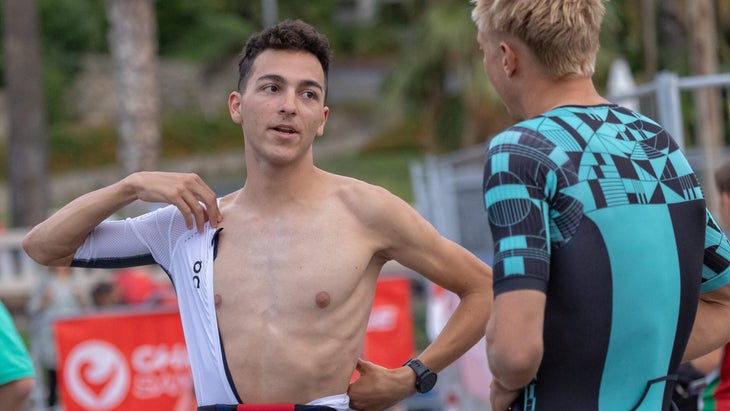New perk! Get after it with local recommendations just for you. Discover nearby events, routes out your door, and hidden gems when you sign up for the Local Running Drop.
It’s all but guaranteed that while training for a triathlon – especially your first race or first attempt at a new distance – you’re going to do some very dumb things. Whether it’s heading out on your first ride without knowing how to clip in to your pedals, or fueling with a gas station burrito in the middle of your long ride, sometimes things that sound harmless in the moment can turn out to be quite a bad idea. Bloopers and blunders are almost a rite of passage in triathlon, teaching us what works (and perhaps more importantly, what completely, definitely, absolutely does not work at all).
The good news: You’re probably not the first one to make a given mistake. When it comes to boneheaded ideas, coaches have seen it all (and then some), and rarely bat an eye when an athlete shares a good idea that really (really) isn’t. We asked coaches to share common themes in bad advice and how to steer clear from being on the blooper reel.
Bad triathlon advice: Low-calorie training and delayed fueling for weight loss
Underfueling your training poses many risks, said Jenna-Caer Seefried, a triathlon coach and multi-time Ironman World Championship qualifier. By limiting fueling before working out or stretching out when you eat after a hard training session, you put your hormonal health at risk – this is true for both women and men. Also on the line: bone density, immunity, performance, and recovery.
Why it’s bad advice:
Underfueling long sessions leads to poor recovery and reduced training quality. Athletes with a mentality of limiting their nutrition despite their body’s needs also face increased risks of Relative Energy Deficiency in Sport (RED-S).
Delaying post-training nutrition hinders muscle repair and adaptation. Instead of getting fitter, you’ll become more tired, irritable, and prone to illness and injury. Training should build strength, not break you down.
Bad advice: Focusing solely on run fitness

Athletes who want to run well off the bike tend to lean more toward run training, said Alison Freeman, a USAT Level II-certified and co-founder of NYX Endurance. The logic makes sense on paper, but while you need run fitness as a triathlete, neglecting the other disciplines will not serve your finish time well.
Why it’s bad advice:
“Triathlon success is built on bike fitness,” Freeman said. “If you want to run well off the bike, of course you need run fitness … you need to have so much bike fitness that you can get off the bike and your legs are like ‘whatever’ and then you start running.”
While it can be challenging to balance the many training requirements of triathlon, you must be a multi-faceted athlete to succeed. In addition to bike fitness, you also need to pay attention to executing effective pacing to make sure you save enough run fitness for the second half of the event.
Every training session is also an opportunity to build your nutrition and hydration strategy. “If your body is not fueled and hydrated, it doesn’t matter how fit you are, you’re not going to run well,” Freeman said.
Bad advice: Make your own race nutrition
“Far too often, I encounter athletes that have taken the advice to concoct their own race nutrition for long-course events, like marathons and Ironman races,” said Tony Rich, head Coach at EventHorizon. “There are very few good reasons for taking this advice. Perhaps some medical nutrition requirement. But I can think of very few.”
Why it’s bad advice:
Taking nutrition matters into your own hands introduces unnecessary complexity into your race. In addition to procuring ingredients from various sources, you’ve got to combine those ingredients at the right ratio, figure out how to store it to maintain integrity, and make or procure a container that will be efficient enough to use in a race. Why reinvent the wheel when plenty of perfectly proportioned nutrition products are available?
“Even if you are extremely astute at concocting a valid mixture you learned, the likelihood that it’s going to be as good or better than the collective knowledge of sport science PhDs across half a century is infinitesimal,” said Rich. “Your stomach is not going to know the difference even if you are good at it, despite what your buddy or the internet says. Trust the science of over-the-counter race nutrition product, minimize risk, and save yourself some time.”
RELATED: Training Is Getting Serious Again, Does Your Diet Match?
Bad advice: Shock your system to acclimate to tough conditions
“Five days before a draft-legal Olympic-distance race, one coach had an athlete do a three-hour brick workout at race pace in the heat of the day to acclimate to the heat. Temperatures were well into the 90s Fahrenheit,” said Olympic cycling and triathlon coach Gale Bernhardt. “It was too much volume and intensity in a stressful environmental condition, too close to race day.”
Why it’s bad advice:
Bernhardt notes the athlete far underperformed at the race, and understandably so – heat acclimation takes weeks, not hours. Without a gradual acclimation period, suffering through a tough workout in tough conditions does little more than leave the body feeling wrecked. “Any work on heat acclimatization should have begun some 14 days prior to race day – at minimum,” said Bernhardt.
RELATED: The History and Science of Heat Acclimation
Bad advice: More money will fix it!
“Tell an endurance athlete that XYZ product will help them take off so many seconds from their finishing time, and it will be as if money will burn a hole in their pocket,” said Rich. “They will often take the advice and run right out and buy it. Triathletes must know that the 18 swim aids that are at the bottom of their swim bag, many of them procured based on a friend’s advice. And don’t get me started on the newest ‘sport supplement.’”
Why it’s bad advice:
That superbike that you put on a credit card might not have the impact you think it will – especially if you’re a middle-of-the-pack age-group athlete. Those pool tools probably won’t shave off seconds of your time, especially if you only use them once in a while. We want to believe this one thing will be the key that unlocks faster race splits, and that makes us susceptible to shoddy advertising: “Manufacturers of these products know very well that this phenomenon exists, so they make millions every year with glowing promises of faster splits, watts saved and lower drag coefficients,” said Rich. “Athletes should remember one cardinal rule, regardless ofthe advice they receive, and that is, the most important piece of equipment is yourself. Just train harder and more efficiently, it’s cheaper.”
RELATED: Triathlete’s Guide to Buying Gear
Bad advice: Train hard all the way to race day
“A new athlete came to me for coaching in 2019. He had just raced his first Ironman and finished, but felt tired a lot of the time during training and underperformed his expectations. The prior coach had scheduled a 16-18-mile run for the athlete just 7 days out from his Ironman race,” said coach Jordan Blanco at Avid Endurance. “What is more, much of the run was recommended at 10-15 seconds faster than race pace. Four rounds of three miles at race pace/one mile easy with some warm-up and cool down!”
Why it’s bad advice:
Hard efforts take recovery, and long runs with high-intensity efforts are as hard as it gets. The stress and muscular damage from such a run requires ample recovery time. That’s why your longest run in training should be completed weeks before the race, not the week before the race. “The tapering of long-run volume allows the athlete to recover appropriately from the longer runs and absorb the endurance work, leaving them fresher for a great performance on race day,” said Blanco.
RELATED: How to Get Race-Ready In Six Weeks
Bad advice: Eat alllllll the things!
“Most of the bad advice I’ve encountered for triathlon is related to long-course fueling,” said coach Matt Smith of Sansego. “I’ve had athletes read they should be taking in 1000 calories per hour on the bike or to ‘eat real food.’ This translates to having a literal pizza on the aerobars, pockets stuffed with tuna sandwiches, and even pureed sweet potatoes in 1/2 gallon ziplocs hanging off the aerobars.”
Why it’s bad advice:
The body simply can’t absorb that many calories that quickly – and when it can’t absorb them, the body shows them the door. Unless you want to spend your race in a port-o-john or with your head in a trash can, it’s best to keep your fuel to a reasonable rate. “I recommend keeping fueling simple for long distances: 250-325 calories per hour, mostly liquid or easy to digest items like sports nutrition products,” said Smith. “Also using what you want to use on race day in training to test how your body responds under similar output.”
RELATED: Ask Stacy: How Soon Before a Race Should I “Train My Gut”?
Bad advice: You can hack your way to endurance.
“A few years ago, CrossFit Endurance was all the rage,” said Smith. “While functional strength like CrossFit has its place in endurance sports training, I saw workouts for full iron-distance racing full of things like, ‘Do 5 sets of max lift squats then go run 3 miles hard or ride 20 miles,” The theory was these kind of workouts replaced the long rides and runs.
Why it’s bad advice:
We all want to believe we can get all the gains of endurance training without actually doing the endurance training. But short, intense workouts in the weight room only make you better at short, intense efforts in the weight room. “There is no science that backs up being able to use power lifting to develop aerobic capacity to complete a five- to eight-hour bike ride or a three- to five-hour run,” said Smith. “To develop the mitochondrial density and aerobic capacity for long-distance racing, you need to do long rides and runs.”
That doesn’t mean you have to go super-long every weekend, but expecting a 2-hour workout with weights to replace a long ride just isn’t sound. If you’re looking to cut a long ride shorter, try adding intervals instead: For Ironman racing, Smith recommends swapping out a six-hour ride with 4 hours and 30 minutes instead, slotting in a set of 4 x 20-minute intervals at threshold with 5-minute recovery periods. This can maximize time and adaptation the right way.
RELATED: Too Many Triathletes Are Getting This Part of Training Wrong
